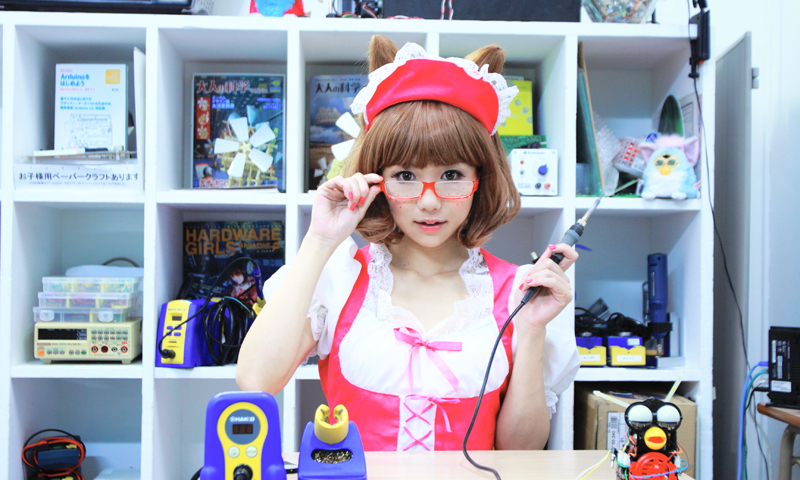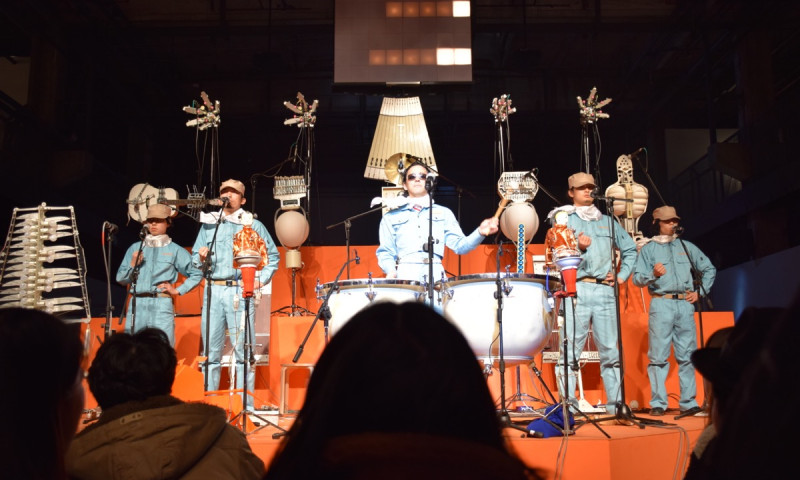
TOKYO CUTTING EDGE CREATORS by Julie Watai #11 featuring Frenesi: The Singer-Songwriting-Animator

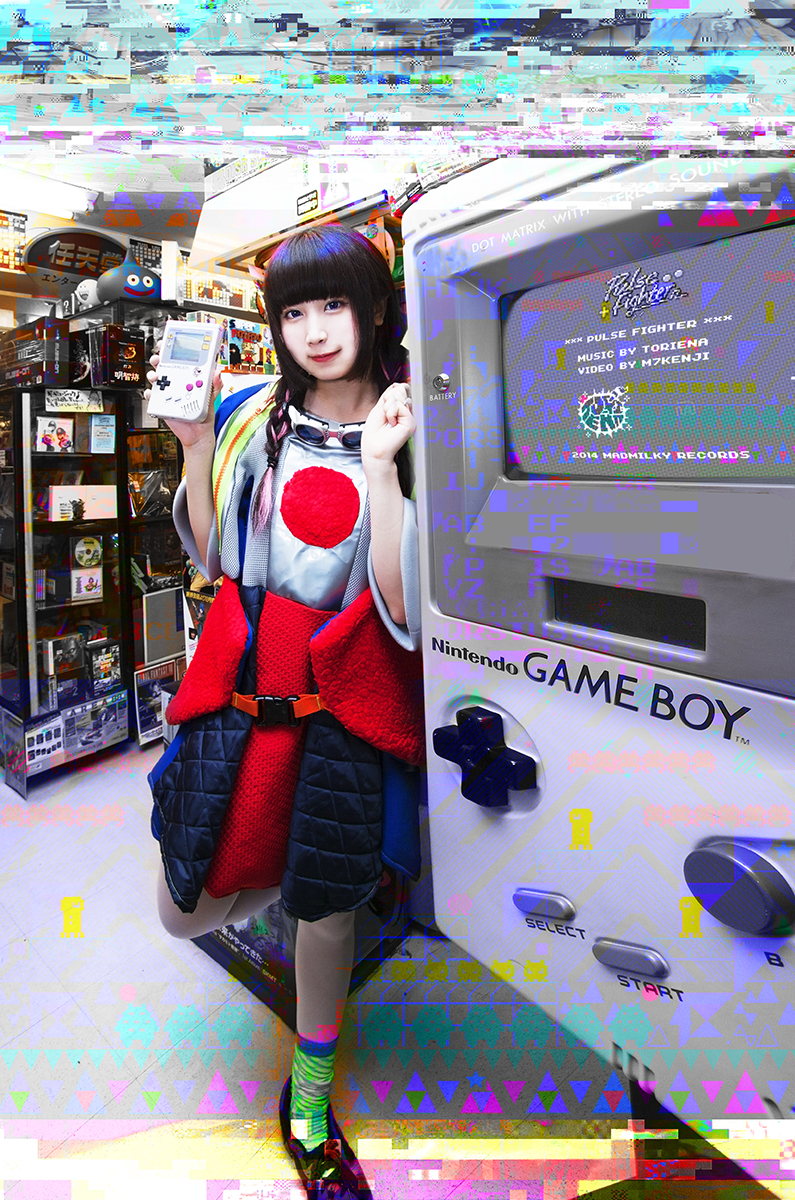
Sponsored Links
TOKYO CUTTING-EDGE CREATORS by Julie Watai is column series, which covers Tokyo’s latest cutting-edge culture! In this series she’ll be interviewing creators that have caught her interest, in order to discover the latest cutting-edge culture in Tokyo. For our first installment, we interviewed artist Ai☆Madonna, for the second time welcoming Junya Suzuki, who has been working for fashion label “chloma”, and for the third time we had discussion with Etsuko Ichihara, an artist/ director of wild ideas. For this time we will be interviewing TORIENA, who has been working as a chiptune girl.
東京の最先端カルチャーを常に追いかけ続けてきたJulie Wataiさんの連載『TOKYO CUTTING-EDGE CREATORS by Julie Watai』。この連載では、Julie Wataiが注目するクリエイターとの対談を通じ、新たな東京の最先端カルチャーを発見していきます。初回では愛☆まどんなさん、第2回目ではファッションレーベル”chloma”の鈴木淳哉さん、第3回目ではアーティスト・”妄想監督”の市原えつこさんにインタビューをさせて頂きました。そして今回のゲストは、チップチューンガールTORIENAさんです。
Julie: TORIENA-chan, long time no see! Thank you for meeting with me today.
Julie : TORIENAちゃん、お久しぶりです! どうぞよろしくお願いします。
TORIENA: I’d like to thank you, too!
TORIENA : よろしくおねがいします!
Julie: To start things off, please introduce yourself for people who may be reading about you for the first time!
Julie : ではまず最初に、初めて知る方もいるかと思うので、自己紹介の方をお願いします!
TORIENA: I’m TORIENA (toe-ree-eh-nah).
TORIENA : TORIENA(とりえな)です。

I was born in 1993, and I’m a chiptune girl ♀. I’m chairwoman of the Japanese chiptune music label, MADMILKY RECORDS. I make do all of the sound work (lyrics, compositions, arrangements, and vocals) and art (illustrations and designs) by myself. I’m good ad using the GAMEBOY device and LSDj (Little Sound DJ) to make hard, pop-sounding music, with wild-like characteristics. I’ve performed at Square Sounds Melbourne 2015 (Australia) and Lucca comics & game 2015 (Italy). I’ve also contributed songs and the like to music games by Konami and Capcom.
1993生まれのチップチューンガール♀。日本のチップチューン音楽レーベル「MADMILKY RECORDS」主宰。 サウンド(作詞・作曲・編曲・歌)&アート(イラスト・デザイン)を全てセルフプロデュースで行っている。GAMEBOY実機+ LSDjを使ったポップでハードな作曲を得意とし、暴れまくるスタイルが特徴。「Square Sounds Melbourne 2015(オーストラリア)」「Lucca comics&game 2015(イタリア)」出演。コナミ社、カプコン社の音楽ゲームに楽曲提供など。http://toriena.net/
Recently I changed my desktop music and I’ve been working on music!
最近はDTMも交えて作曲しています!
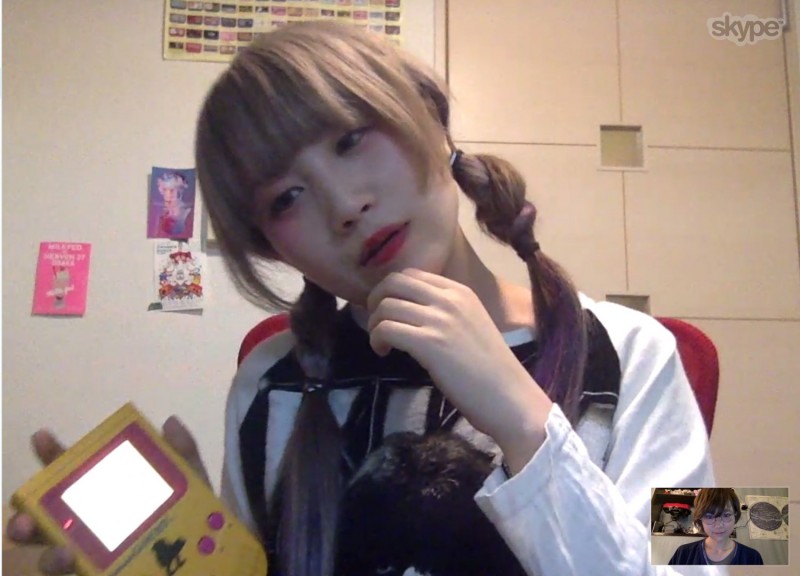
This interview was conducted via Skype./対談はSkypeチャットを通じて行われました。
Julie: I first got to know you through Hally (the first so-called chiptune musician in Japan, who Julie used to perform with as part of a vocal/chiptune unit, called JulieHally), and at the time you were just a university student, which made me wonder how someone so young knew about chiptune.
Julie : TORIENAちゃんのことを私が最初に知ったのはHallyさん(日本人初と言われているチップチューンミュージシャン、その昔JulieとはJulieHally名義でボーカル・チップチューンユニットをしていました)からなんですが、当時は女子大生で、なぜそんな若いのにチップチューン知ってるのかなって不思議でした。
The chiptune genre, in a loose sense, was derived from techno, but mainly refers to music that was made from internal sound source chips in game devices from the 1980s. There are fundamentalists, or maniacs, perhaps, that say chiptune only includes original game chip music. It’s a genre with a lot of middle-aged male fans, reminiscing about playing the Famicon (NES) when they were kids. But the music itself is really cool, and became more and more popular!
チップチューンっていう音楽ジャンルは、広い意味ではテクノから派生しているんだけど、主には1980年代に発売したレトロゲーム機の内臓音源チップで作られる音楽のことなんですね。実機演奏されたものだけがチップチューンであるという「実機原理主義者」もいたりして、とにかくマニアック。昔ファミコン少年だったっていうノスタルジーな流れからのおっさんリスナーが多いジャンルでもあるんです。でも楽曲もすごくかっこいいし、話題になっていたんですよ!
TOREINA: That makes me really happy!
TORIENA : わー嬉しいです!
Julie: At the time there weren’t any younger people into chiptune, and we kept talking about how to get more people into the genre. I feel like that’s where you came in and breathed new life into the chiptune genre.
Julie : 当時はチップチューンジャンルに若いひとがいなくって、どうにかしてジャンルに盛り上がりが欲しいよねって話していたんですよ。そこにTORIENAちゃんが現れて、チップチューンジャンルに新たな流れを作った、そんな印象です。
TORIENA: Yeah, as for there not being many younger artists in the genre, when I first started out I used to think about how there weren’t many other people my age and it was a little sad.
TORIENA : そうですね、若いアーティストが少ないというのは始めた頃から薄々思っていました。同い年くらいの子があまりいなくて少し寂しかったりもしました。
Julie: About when did you start doing concerts? I feel like back then most people in the audience were in their late thirties.
Julie : 最初にライブした時期っていつくらいなのかな? あの頃はほぼ客層30代後半とかだったような。
TORIENA: My first one was on February 26, 2012!
TORIENA: 2012年2月26日ですね!
Julie: Four years ago then, yeah? Seeing you featured in so much media, I figured it’d been much longer.
Julie : 4年前なんだね。随分経った印象だったけど、それだけTORIENAちゃんのメディアでの露出量もすごくて、もっと時間が過ぎていたものかと。
TORIENA: I felt encouraged to make something myself, and a strong urge to get started on putting something out there quickly, and then as a result I started working more and more. (laugh)
TORIENA : そうですね、私やりたいなーつくりたいなーというものが結構湧いてくるし、それを早く具現化しないと! という気持ちが強いので結果的に活動量が多くなっているんだと思います(笑)
Julie: Somewhat unrelated, but I feel like all of your work ties into your own unique world. By the way, how did it feel when you did your first concert?
Julie : うん、多岐に渡っているけども全てTORIENAワールドで繋がっている感じ。ちなみに最初のライブはどんな感じだったの?
TORIENA: I packed about 30 minutes worth of music datea into a single LSDij and just danced around on stage while the music played in the background.
TORIENA : LSDjの1つのデータにライブ30分ぶんの曲を詰め込んで1台で流しっぱなしでガンガン踊ってました。
Julie: LSDj are professional sound cartridges for GAMEBOY used to make music, right? Which means for your first concert you used music straight from your GAMEBOY! I’m in awe of how retro-cool that is! (laugh)
Julie : LSDjって、ゲームボーイからの作曲や音出し専門のカートリッジだよね。ということは、最初のライブからゲームボーイ(実機)からの直出しだったんだ! その渋さにも驚きです!(笑)
TORIENA: About the LSDj, I had an older classmate in university who said, “Hey TORIENA, let’s make some chiptune together!” I went with him to Kyoto to the holy land (?) of chiptune, Café la siesta, and when we told the master there that we wanted to make some chiptune, he gave us a cassette and that’s how I got my my first LSDj.
TORIENA : LSDjは大学の先輩が「TORIENAちゃん、一緒にチップチューンやろうよ!」と声をかけてくれた先輩がいて。その先輩と京都にあるチップチューンの聖地(?)Cafe la siestaに行ってマスターに「チップチューンやりたいんですけど!」って言ったらカセットをくれてそれで最初のLSDjをGETしました。
Julie: Wow, he sounds like an amazing guy! I went to siesta way back when, too. I’m from the Kansai area, and I have good memories of pulling all-nighters doing chiptune events there. I think it’s pretty hard to compose music on an LSDj and arrange it with the hardware; even for professional musicians it seems like the hurdle is set pretty high. And to think that a cute, female university student was doing it would just dazzle and captivate people.
Julie : そのマスター素晴らしすぎるな! siestaは私も昔行ったなあ。私は関西出身なんだけど、VJとしてそこのチップチューンイベントでオールした記憶が。LSDjって作曲もハード自体を揃えるのも、プロのミュージシャンにとってもなかなかハードル高いと思うんだけど。それをカワイイ女子大生がやってしまうというところでもう謎すぎるしメロメロになってしまいましたね。

Photo : Julie Watai Model : PINO 2011年撮影、地元大阪にて。8bitとコスプレ、ファッションフォトの表現を模索していた時期に撮った一枚。
Julie: By the way, what was the first game you ever played?
Julie : ちなみに最初にやったゲームって何だったの?
TORIENA: It was Pokemon Gold and Silver! I still love it.
TORIENA : ポケモン金銀でした! 今でも大好きです。
Julie: That makes sense, since you’re part of the Pokemon generation. Are there any games that have heavily influenced your work? Or what about other influences besides games? Not just when it comes to music, but your unique vision.
Julie : なるほど、ポケモン世代だったのね。今も作品に影響を受けているゲームソフトってある?それか、そういうのはゲームじゃなく別のものだったりするのかな。音楽だけではなく、TORIENAちゃんの世界観に。
TORIENA: I wasn’t a big gamer, so when it comes to my vision I’d have to say the influences of (manga artists) Junko Mizuno and Lun Lun Yamamoto, and Super Milk-chan, are stronger. I also like pop and moe anime from the 00s, like DiGiCharat, which might also have slightly influenced my work.
TORIENA : うーん、私はあまりゲームっ子ではなかったのでどちらかというと世界観的には水野純子、山本ルンルン、スーパーミルクちゃんあたりからの影響がつよいです。あとデジキャラットとかも好きで、00sの萌えアニメのポップさも若干あるかもしれないです。
Julie: Oh, I see. So most of your influences come from illustrations. Were there any musical artists you were into?
Julie : なるほどー。イラストからの影響が大きいんだね。音楽でハマったアーティストはいた?
TORIENA: I was really more of a passive music listener, but I do think there were quite a few artists who influenced me.
TORIENA : 音楽は本当に雑食で好きで影響を受けたアーティストはかなり多いと思います。
Julie: So you listened to regular j-pop and the like? I want to know what the first CD you ever bought was!
Julie : 普通のJ-Popとかは聴いてた? 初めて買ったCDを教えて欲しい!
TORIENA: As far as j-pop goes, I liked Judy & Mary, Sheena Ringo, and POLYSICS. The first CD I ever asked my parents to buy was Akiko Yano’s Piyano Akiko and the first CD I ever bought with my own money was Hilary Duff’s Metamorphosis.
TORIENA : J-POPはジュディアンドマリー、椎名林檎、POLYSICSがすきでした。初めて親にねだって買ってもらったCDは「ピヤノアキコ/矢野顕子」で、自分のお小遣いで買ったCD「Metamorphosis/ヒラリーダフ」でした。
Julie: I can totally see that! I think all of these artists are definitely tied in to your imagery.
Julie : なんか納得した! どのアーティストも、TORIENAちゃんのイメージにどこか繋がるように思います。
TORIENA: Ohhh~!
TORIENA : ほええ〜!
Julie: (moe)
Julie : (萌)
TORIENA: Really? (laugh) That’s funny.
TORIENA : そうですか?(笑) おもしろいですね。
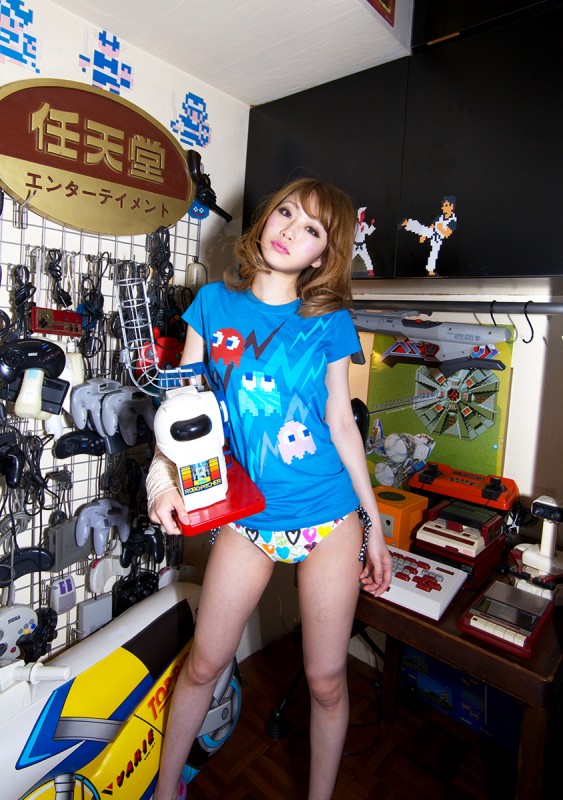
Photo : Julie Watai Model : Komayu Location : Game Bar CONTINUE 2013撮影 大阪、心斎橋のゲームバーにて。この頃は「セクシーな女性とギーク」な組み合わせのグラビアスナップをメインに撮影していた。
Julie: Yeah, I feel like you have a really girly image about you. So from the time you were listening to pop like that until the time you debuted as a chiptune artist, what did you initially find appealing about chiptune?
Julie : うん、なんか、自分を持ってる女性像があるとことか。そんなポップスを聴いていたところからのチップチューナーデビューでしたが、TORIENAちゃんにとってチップチューンの魅了とは?
TORIENA: That the sound was like minimal techno!
TORIENA : 音がミニマルテクノみたい!
Julie: No doubt about it, it’s certainly minimal.
Julie : うん、確かに超ミニマルだよね。
TORIENA: About the time I got the LSDj, I began to listen to chiptune noise and thought it was really minimalist. I liked the sound of it.
TORIENA : ちょうどLSDjゲットしたときにAlvanotoとか聴いてて、チップチューンのノイズを聞いた時に「ミニマルじゃーん」っておもいました。音が好きです。
Julie: So that’s what you connected with! For people of my generation, we have a culture-based reaction to chiptune, so it was common to feel connected with it just for that reason alone, so I’m glad to find out your reason.
Julie : そこと繋がっていたのね! 私世代からするともうチップチューン音に反応するカルチャーのベースが出来上がっていて、そこからハマるという流れが一般的だったから、教えてもらえてよかったです。
TORIENA: I see. I didn’t find it strange that it felt like game music. I like distorted guitar and bass sounds, so I think piercing-like game music is totally awesome! Like it’s so addictive.
TORIENA : なるほど。ゲーム音楽っぽい~っていう感じは不思議となかったです。ギターもベースも歪んでる音が好きだったので、突き刺さる電子音が最高にイイ! ハマる! って感じですね。
Julie: I see. So that’s the kind of chord it struck with you. By the way, is there anything you feel has changed about the concert scene since you gave your first concert in 2012? Or something related to events in general?
Julie : そっか。そう受け取っていたんだね。ちなみに初ライブをやった2012年と比べてチップチューンのライブシーンで変わったなって気づいたことはある? イベントによるかもしれないけども。
TORIENA: Um, that’s a difficult one. (laughs) As usual, I feel it’s with the scratchy-sounding machines at chiptune events!!! But I don’t think many people in the audience would notice a difference. A lot of my listeners were originally into bands, pop music, or idols, so it feels like something about chiptune really strikes a lot of different people. As for the scene itself… I don’t think it’s changed much. It’s difficult to say.
TORIENA : うーん、難しいですね(笑)。相変わらずチップチューンごりごりのイベントでは実機!!! って感じでお客さんの層も変わらないとおもうんですけど。私のリスナーはもともとバンドが好きだったり、ポップスが好きだったり、アイドルが好きだったりする人がいて、チップチューンって割と色んな人に刺さる音楽なんだなーと思ってます。シーン自体は……やっぱりあまり変わらないかなぁ。難しいですね。
Julie: “Culture mixes” are really popular with younger people now. But maybe before you started doing concerts, they were interested in that sort of genre, but just didn’t have the opportunity to get to know it. When you performed at Famimode (a chiptune festival), before you took the stage, suddenly the front row changed to younger people who were dancing, dressed from head to toe in Harajuku-style fashion, and it was quite impressive.
Julie : 若い世代はカルチャーミックスが主流だものね。ただTORIENAちゃんがライブする以前ってそういう尖った音楽ジャンルに興味はあるけど知るきっかけがなかっただけかもしれない。TORIENAちゃんと出演させてもらったファミ詣(チップチューンのフェスイベント)では、ステージ直前になると突如最前列が原宿系のファッションに身を包んだ若者に入れ替わってめっちゃ踊っていて、それが印象的だったなぁ。
TORIENA: How can I say it, but even for me, even though I started putting out music in 2013, only last year has become easier to hear, and since then the frequency of DTM has spread.
TORIENA : なんというか私も、2013年頃から歌を入れ始めたり、去年からはより聴きやすいようにDTMで周波数広げてますから。
Julie: (That’s a neat way to put it…)
Julie : (周波数広げる、って表現かっこいいな…)
TORIENA: After all, it’s difficult to listen to it just with the actual equipment. It may just be a problem with my technique, but the longer I work, the more I want to hear music from other people, which gives me too much of an edge.
TORIENA : やっぱり実機だけでしっかり聞かせるって難しいんですよ。私の技術が至らないだけかもしれませんけど、活動をしていくなかでもっと色んな人に聞いて欲しいとなったときに、エッジが効きすぎてるんですよね。
Because of me using this original, scratchy-sounding device, and because there’s a history of that sound that has grown from it, I feel like there’s a completely different essence in the impression I get from people who suddenly do video game sounds on DTM. Or at least to those who are familiar with the original devices. (Some people might think that sounds elitist, though.) To those raised on the sound from these devices, they might consider me selling out, but recently I’ve been thinking of doing pop-like, original sound device + DTM + song stuff.
もともと私はごりごりの実機勢で、実機で育ってきたヒストリーがありますから、想像でいきなりDTMでピコピコやってる人とは違うエッセンスは絶対あると思います。実機特有の癖を熟知しているというか(偉そうに言いすぎかもですが)。そういう実機育ちが、セルアウトすることに意味があるんじゃないかなと思いながら、最近は実機+DTM+歌でポップスっぽいことをしようと思ってます。
Julie: It seems like there’s somewhat of a technical limitation when it comes to expressing yourself in different ways. Listeners might get into chiptune through DTM, and in following the appeal of it, get into the original scratchy-sounding device style. At least if you get heavily into something and the original entrance for it isn’t all that wide (or easily approachable).
Julie : 多彩な表現をやってく場合に技術的な制約があるとそうなりますね。リスナーも入り口はDTMの楽曲で、その中に入っているチップチューンの音色に魅せられて追求した結果ごりごりの実機派になる流れもありそうだしね。深みにハマるには最初の入り口は広くないと(とっつき易さがないと)、って思うよ。
TORIENA: I don’t think there’s many that get into it from the original sound device way any more. So I’d like to dare to become a doorway into it myself. For example, “Oh you listen to TORIENA! You know, if you dig a little deeper, there are even more retro-cool chiptuners out there!” or something like that. That’s my current goal.
TORIENA : そういう実機への入り口となる人ってかなり少ないと思うんです。だからあえて入り口になりたい。例えば、「ええ~お前TORIENA聞いてんの! もっと渋いチップチューナーいるぜ、もっとDigれよ!」って言われるまでになりたい。それが今の目標です!

Julie: I can wee why you respect those stubborn older chiptune guys, then. You’re more stoic than I had first thought.
Julie : うん、TORIENAちゃんが頭の固いおっさんチップチューン勢からも愛されリスペクトてる理由がわかるな。やっぱり思想もストイックだよね。
Julie: Last year (2015) was a really busy one for you.
Julie : 去年2015年は超多忙な年だったよね。
TORIENA: Yeah, I did a lot of overseas concerts.
TORIENA : そうですね、海外ライブが多かったです。
Julie: You mean in Australia, Italy, and China?
Julie : 海外、オーストラリアとイタリアと中国だっけ。
TORIENA: And then England and Italy again.
TORIENA : あとイギリス、イタリアですね。
Julie: Wow, that many! How was the excitement compared to Japan?
Julie : そんなに行ってたんだ!ライブは日本と比べて盛り上がりはどうだった?
TORIENA: A lot of it was hard/challenging, but the result was really fun. People were really into it!
TORIENA : いろいろ大変だったんですけど結果的に楽しかったです。盛り上がりました!
Julie: Whenever I think of Europe I feel like there’s a lot of people really hardcore about dancing there.
Julie : ヨーロッパは激しくダンスする人が多そうなイメージ。
TORIENA: But if I give it some thought, I don’t think there’s that much of a difference between Japanese audiences and audiences overseas.
TORIENA : でもよく考えたら日本も海外もノリはかわんないかもな~とも思ったり。
Julie: Then you did a collaboration with SPINNS and Village Vanguard.
Julie : そしてスピンズ、ビレバンとのコラボも。

TORIENA: Yeah, which I think was a good turning point.
TORIENA : ですね、これはいい転機だったと思います。
Julie: You created designs for the SPINNS clothing, but how did you convey kind of image were you going with the apparel?
Julie : スピンズの服もプロデュースしてたけど、アパレルのデザインってどうやってイメージを伝えたりするものなの?
TORIENA: I asked myself what items I’d want from a clothing store, drew a rough sketch, went to pick out the fabric, described the details to the clothing makers(?), and then it was done. Mostly I described it using pictures.
TORIENA : 私が服屋さんにどんなアイテムが欲しいですか?と聞いてラフを描いて、布を選びに行って、服をつくる(?)会社さんにデティールを説明して、そして完成しました。主に絵で説明しました。
Julie: So that’s how you did it. You were really involved from the very beginning. There were quite a few items, but it really caught my interest how all of them were sweet with an edge, and how they were so well-connected with the vision of your music and drawings. What kind or reaction did they get?
Julie : そうやって出来上がったんだね。最初からガッツリ関わって作ったんだ。アイテムは何種類かあったけども、どれも甘さがある中にもエッジが立っていて音楽やイラストとの世界と見事に繋がってるな、って関心しながら見てた。反響はどう?
TORIENA: Of course people who already knew of me interested in the items, but I was glad to see girls who didn’t know me buying the items because they thought they were cute. Seeing parents buy items for younger girls also left a big smile on my face. Also a lot of people were kind enough to say they were impressed!
TORIENA : わたしを知っている人はもちろん、TORIENA知らないけど服かわいいし買った、みたいな子がいてうれしかったです。あと若い子が親に買ってもらったとか、そういうエピソード微笑ましいな、~と。あとやっぱり色んな人からすごいねって言っていただけました!

Julie: SPINNS is a Harajuku-style fashion brand that’s become a staple with university students. I can see people getting into your music from the fashion, which I’m deeply interested to see.
Julie : スピンズっていうと原宿系のファッションでは学生さんの間で定番のブランドですしね。服から音楽に入る流れもありそうで、そういうのも興味深いですね。
TORIENA: Yes, there were some girls like that and I was really happy~
TORIENA : そうそう、そういう子がいて、嬉しい~と思いました。
Julie: It likes like your concerts have an increasingly larger culture mix feel to them. In light of that, is there any concepts you want to explore in the future?
Julie : TORIENAちゃんのライブ、ますますカルチャーミックス感が高まってそうですね。では、今後これやってみたいなっていう構想があったら聞かせてください。
TORIENA: You’re right, and even now I’m still changing up my concert style. Up until now, having a fun feel to it has always been at the forefront, but I’ve began to feel like I want to add to the enjoyment aspect, and polish it into a show that’s easier to watch. So I’ve been thinking of turning it into a show that has a proper introduction, development, turn, and conclusion to it. I also want to prepare some VJ material.
TORIENA : そうですね、ライブスタイルも今は結構変えたりしています。今までは楽しい気持ちを前面に押し出すかたちでしたけど、4年もライブなどしていると、楽しいにプラスして、もっと洗練された見やすいライブにしたいなという気持ちが生まれてきました。なので、起承転結のあるようなライブにしていこうかな? と思っています。VJ素材も準備したりしたいです。
In addition, I want to make the music more fascinating, more like a comprehensive form of art. I think the artistry of music isn’t just about sound alone, and includes artwork and video. I’d love to do a solo concert, too!
あとは、もっと総合芸術として、音楽を魅せていきたいですね。音楽の芸術性って音だけじゃなくてアートワークだったり映像だったり人物像も全て含めると思っているので。ワンマンもやりたいですね!
Julie: The MV you released is really interesting. It uses a nostalgic kind of digital animation, but it has current-era appeal to it. If you could turn that into something the audience is able to feel at concerts, it would be something amazing. I have no doubt that you’ll be able to do a solo concert soon. Thinking about even farther into the future, how do you hope to see yourself in say, 10 years?
Julie : リリースしているMVも、とても面白いよね。ノスタルジックなゲームを思わせるデジタルアニメーションだけど今っぽいセンスが魅力的。あの世界観がライブで感じられるようになったらすごいよね。TORIENAちゃんなら、ワンマンすぐ出来そうだけどなぁ。もっと先の話、例えば10年後にはどうなっていたいって思う?
TORIENA: We’ve finished MV shoot, so now I want to help it spread its wings! In 10 year’s I’ll be TORIENA(33)…
TORIENA : 今、実写MVも撮り終わってるので、羽化させたいですね! 10年後はTORIENA(33)か……。
Julie: Don’t put your age after your name like that…! (laugh)
Julie : 名前の後に()で年齢つけるのやめましょうよ笑
TORIENA: Hehe. (laugh) Well, I’d like to be an artist that makes a mark on the history of chiptune. If possible, I hope it’ll be recognized as a proper musical category.
TORIENA : ふふ(笑)。でも、チップチューン音楽史に刻まれているようなアーティストになっていたいです。できたら、音楽的にもちゃんと認められていたらいいな。
Julie: It would feel more legitimate as a genre if it were, wouldn’t it. I think it would be great if you became an artist more widely recognized throughout the world! I’ll definitely be cheering you on until I’m one foot in the grave. Thank you so much!
Julie : チップチューン音楽史でいうとそれはもう確実でしょうけど。確実にもっと世界的に広く知られるアーティストになっていると私は思いますよ! そんなTORIENAちゃんの活動を草葉の陰からずっと応援しております。ありがとうございました!

Photo : Julie Watai Model : TORIENA Location : Super Potato Akihabara
2014年撮影、TORIENAちゃんと知り合ってすぐに撮らせてもらった彼女のアーティスト写真。この時の撮影風景は動画メディア「VICE」の「Creators Project」に掲載されたJulieのドキュメンタリー動画にも映っています。
Out of our talk, I got the impression that TORIENA had been baptized in various different cultures from a young age. With music serving as an axis, she continues her work by establishing herself as a self-produced model, and creating drawings and apparel. When it comes to common sense, the younger the woman is, the harder it is not to reflect the opinions of those around you. Because women are instinctively social, they are therefore affected, and it can be an age where deciding on what’s most important in a world where what’s accepted has been decided, can weigh heavily on her. So in expressing her own free style in the way she does, I’m convinced that she’ll continue with her activities in the future as a new pop icon for women her age, for her strong sense of passion at times.
今回の対談を通じて。TORIENAちゃんは幼少期から様々なジャンルのカルチャーから洗礼を受け育まれた確固たるビジョンがある人なのだと感じた。音楽を軸として活動しつつ、イラストやアパレルのプロデュース、モデルに至るまで自身による完璧なセルフプロデュースで成立している。普通の感覚であれば若い女性であるほど、周りの意見に左右され個としての表現は難しくなるだろう。女性であるということは本能的に社会性に影響されるが故に、何が世の中で良しとされているかという部分を最重要視した結果に自分らしく生きる事は不安要素の一つとなって重くのしかかり揺れる年頃でもある。そんな中で自由な表現スタイルを切り開いていく彼女は、時に心強い憧れの存在としても同年代女性からの新たなポップアイコンとして今後も活躍していくのだと確信した。
Read more articles TOKYO CUTTING-EDGE CREATORS by Julie Watai
#3 : Think About Where Humanity Meets Technology with Etsuko Ichihara
市原えつこと考える、“人間性”とテクノロジーの融合
http://tokyogirlsupdate.com/tokyo-cutting-edge-creators-etsuko-ichihara-20160591845.html
#2 : The Future of Fashion with Junya Suzuki from “chloma”
chloma 鈴木淳哉と語る、ファッションの未来
http://tokyogirlsupdate.com/tokyo-cutting-edge-creators-chloma-20160488332.html
#1 : #1 : Past and Present of Akihabara with Ai☆Madonna
愛☆まどんなと語る、秋葉原カルチャーの過去と現在
http://tokyogirlsupdate.com/tokyo-cutting-edge-creators-ai-madonna-20160383506.html
Related links
TORIENA official site : http://www.toriena.net/
Julie Watai official site : http://juliewatai.jp/
Translated by Jamie Koide
Sponsored Links

Studying At A Moving Desk While Going To School? ROCK A JAPONICA’s MV For “KYOUKA SHOCK!” Revealed!

Risa Satosaki Reveals Everything in the MV for “S!NG”!


